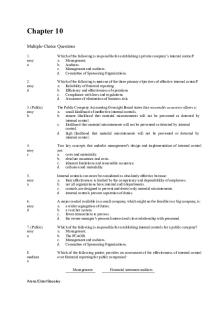Chapter 10 Credit Analysis DOC

| Title | Chapter 10 Credit Analysis |
|---|---|
| Author | Gebby Faraera |
| Pages | 55 |
| File Size | 295 KB |
| File Type | DOC |
| Total Downloads | 50 |
| Total Views | 95 |
Summary
Chapter 10 - Credit Analysis Chapter 10 Credit Analysis REVIEW This chapter focuses on credit analysis. It is separated into two major sections: liquidity analysis and solvency analysis. Liquidity refers to the availability of resources to meet short-term cash requirements. A company's short-ter...
Description
Chapter 10 - Credit Analysis Chapter 10 Credit Analysis REVIEW This chapter focuses on credit analysis. It is separated into two major sections: liquidity analysis and solvency analysis. Liquidity refers to the availability of resources to meet short-term cash requirements. A company's short-term liquidity risk is affected by the timing of cash inflows and outflows along with its prospects for future performance. Our analysis of liquidity is aimed at companies' operating activities, their ability to generate profits from the sale of goods and services, and working capital requirements and measures. This chapter describes several financial statement analysis tools to assess short-term liquidity risk for a company. We begin with a discussion of the importance of liquidity and its link to working capital. We explain and interpret useful ratios of both working capital and a company's operating cycle for assessing liquidity. We also discuss potential adjustments to these analysis tools and the underlying financial statement numbers. What-if analysis of changes in a company's conditions or strategies concludes this section. The second part of this chapter considers solvency analysis. Solvency is an important factor in our analysis of a company's financial statements. Solvency refers to a company's long-run financial viability and its ability to cover long-term obligations. All business activities of a company—financing, investing, and operating—affect a company's solvency. One of the most important components of solvency analysis is the composition of a company's capital structure. Capital structure refers to a company's sources of financing and its economic attributes. This chapter describes capital structure and explains its importance to solvency analysis. Since solvency depends on success in operating activities, the chapter examines earnings and its ability to cover important and necessary company expenditures. Specifically, this chapter describes various tools of solvency analysis, including leverage measures, analytical accounting adjustments, capital structure analysis, and earnings-coverage measures. We demonstrate these analysis tools with data from financial statements. We also discuss the relation between risk and return inherent in a company's capital structure, and its implications for financial statement analysis. 10-1...
Similar Free PDFs

Chapter 10 Credit Analysis
- 55 Pages

Credit analysis lending management PDF
- 106 Pages

Consumer credit chapter 4
- 7 Pages

Consumer credit chapter 2
- 5 Pages

Chapter 10 quiz #10
- 3 Pages

Notes 10 - Chapter 10
- 5 Pages

Instrumental Analysis - Lecture 10
- 13 Pages

CASE Analysis 10 Cutco
- 2 Pages

Poetry Analysis 10 questions
- 1 Pages

Chapter-10
- 19 Pages
Popular Institutions
- Tinajero National High School - Annex
- Politeknik Caltex Riau
- Yokohama City University
- SGT University
- University of Al-Qadisiyah
- Divine Word College of Vigan
- Techniek College Rotterdam
- Universidade de Santiago
- Universiti Teknologi MARA Cawangan Johor Kampus Pasir Gudang
- Poltekkes Kemenkes Yogyakarta
- Baguio City National High School
- Colegio san marcos
- preparatoria uno
- Centro de Bachillerato Tecnológico Industrial y de Servicios No. 107
- Dalian Maritime University
- Quang Trung Secondary School
- Colegio Tecnológico en Informática
- Corporación Regional de Educación Superior
- Grupo CEDVA
- Dar Al Uloom University
- Centro de Estudios Preuniversitarios de la Universidad Nacional de Ingeniería
- 上智大学
- Aakash International School, Nuna Majara
- San Felipe Neri Catholic School
- Kang Chiao International School - New Taipei City
- Misamis Occidental National High School
- Institución Educativa Escuela Normal Juan Ladrilleros
- Kolehiyo ng Pantukan
- Batanes State College
- Instituto Continental
- Sekolah Menengah Kejuruan Kesehatan Kaltara (Tarakan)
- Colegio de La Inmaculada Concepcion - Cebu





